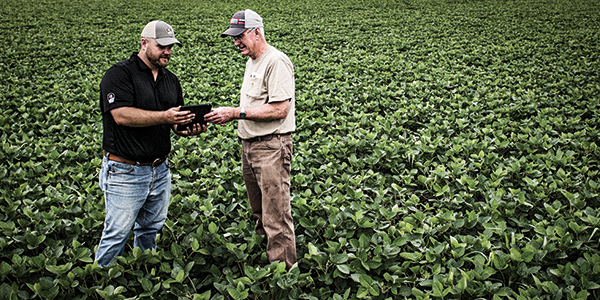AGRONOMIC RESOURCESTO SUPPORT EVERY SEASON
YOU CAN TAKETO THE FIELD
High-yielding Soybeans
Recently, there has been increased interest among growers in achieving higher yields in soybeans. When it comes to corn production, as an industry, we have come a long way. When looking at soybeans, there are some areas in our production practices that can be evaluated to move the yield ceiling higher and increase profits. Below are some key areas to review to raise the yield bar for soybeans.
Fertility
Fertility is especially important for soybeans and is often ignored when using a corn/soybean rotation. pH is always the first place to start. A pH close to 6.5 is desired for greatest nutrient availability. Once the pH is set, looking at soil test data and keeping current soil test records is critical. Soil testing every three years is preferred. Phosphorus and Potassium should be reviewed closely. Soybeans remove a large amount of the P and K they take up. Last season, there were a lot of soybean acres planted. If you are planning to plant soybeans after soybeans, applying DAP and potash based on yields is a good idea to maintain high yields.
Genetics
Studying yield data and performance is a good idea but looking at your fields and their characteristics is equally important. Agronomic packages among varieties should be considered. Protection against BSR, PRR, SDS, SCN, and other diseases can have a large impact on performance.
Treatments
Seed treatments can also add a level of protection to varieties. Seed treatments such as AgriShield® can help against soilborne diseases and insects. Seed treatments such as ILeVO® can protect against SDS. ILeVO® should be strongly considered if soybeans are going to be planted early, as the risk of SDS issues rise. Inoculants can also be helpful to add to your seed to help with nodulation. Rhizobia bacteria in the soil fix roughly 50% of the nitrogen a soybean plant uses, the rest coming from mineralization and organic matter. If you have a field that has low pH, sandy soils, is prone to flooding or has not had soybeans for a long period of time, inoculants can show a positive return. To learn more about AgriShield® seed treatment options go to https://agreliantgenetics.com/agrishield
Planting
 Important planting conditions to pay attention to vary based on your geography and soil types. If possible, conventional tillage or shallow tillage can help create a level seedbed that can warm soils up faster. Vertical tillage tools have become popular due to their speed and ability to level the field with minimal disturbance. However, make sure to apply your burndown before using these tools since vertical tillage tools struggle to take out weeds. Spring burndown options this year should be monitored closely due to wet conditions and minimal fieldwork getting completed in the fall. Timely scouting should be a priority. Along with excellent weed control, good seed to soil contact and planting conditions are also important
Important planting conditions to pay attention to vary based on your geography and soil types. If possible, conventional tillage or shallow tillage can help create a level seedbed that can warm soils up faster. Vertical tillage tools have become popular due to their speed and ability to level the field with minimal disturbance. However, make sure to apply your burndown before using these tools since vertical tillage tools struggle to take out weeds. Spring burndown options this year should be monitored closely due to wet conditions and minimal fieldwork getting completed in the fall. Timely scouting should be a priority. Along with excellent weed control, good seed to soil contact and planting conditions are also important
Earlier planting dates have also stood out for higher soybean yields. This is attractive to a lot of growers because it doesn’t require us to increase production costs. Soybeans are plants that love sunlight. By planting earlier, we can capture more sunlight and raise the bar. The goal is to flower by summer solstice, so we maximize sunlight. When planting earlier, applying seed treatments should be considered to protect against unfavorable weather early in the season. The key to remember is that ideal soil conditions should not be compromised for early planting.
Plant populations have also been played with over the past few years. On farm and other research has shown that we can lower plant populations without sacrificing yield. A lot of this is credited to seed quality, seed treatments, and planters. However, weed control should be considered. With lower plant populations, weed control can be more difficult to achieve and can negatively impact yields. A population of 130,000 to 150,000 is generally a good place to start based on equipment, soils, practices, etc. Narrow rows are also beneficial. 15” or less is ideal for quicker canopy and better placement by using a planter and not a drill. Due to the number of factors that determine ideal plant populations for soybeans, it may be practical to try some on farm research to determine what population is right for your operation.
Weed Control
Weed control is usually a priority for most growers. With tough-to-control small-seeded broadleafs such as Palmer Amaranth and Waterhemp, the goal is to stop weeds before the germinate. A good pre- emerge herbicide with a residual is a must. There are a lot of good pre-herbicides on the market today that have broad spectrum control. Another consideration is layering residual herbicides. In a lot of cases, this is also a must. By overlapping residual herbicides, we can achieve clean fields at canopy. There are a lot of trait options available to growers to achieve clean fields. One caution when growing continuous soybeans is the limited options for post herbicides that can fuel resistance in the future.
Plant Health
Plant health is also important in soybean production. Post applications of fungicides and insecticides are a good practice to implement in our programs. Timing is important and it should be applied at R3. R3 is when one of the four uppermost nodes are 3/16” long. Applying fungicide and insecticide can control diseases and insects as we approach seed development. It is critical that we minimize stress between R4-Full Pod to maximize yields. Timely rains in August are also important to help with seed development.
Summary
.jpg?sfvrsn=fb7e509a_0&MaxWidth=350&MaxHeight=&ScaleUp=false&Quality=High&Method=ResizeFitToAreaArguments&Signature=166B340F11332FB30FE679B426D735E9F31D1355) As we look at each of these factors in soybean production, we should evaluate our current programs to see which areas we are excelling in and which areas we could possibly improve to set the bar higher. We should also ask ourselves, what areas will result in my largest increase in soybean production? Talking to your LG Seeds Sales Account Manager and Technical Team Agronomist is helpful to select the right varieties and treatments to align with your farming practices.
As we look at each of these factors in soybean production, we should evaluate our current programs to see which areas we are excelling in and which areas we could possibly improve to set the bar higher. We should also ask ourselves, what areas will result in my largest increase in soybean production? Talking to your LG Seeds Sales Account Manager and Technical Team Agronomist is helpful to select the right varieties and treatments to align with your farming practices.
Sources and additional information:
http://www.cornandsoybeandigest.com/soybeans/5-tips-best-soybean-yields
http://cropphysiology.cropsci.illinois.edu/research/six_secrets.html
https://unitedsoybean.org/article/5-expert-tips-for-higher-soybean-yields
https://crops.extension.iastate.edu/cropnews/2017/10/what-look-choosing-soybean-varieties
https://www.extension.purdue.edu/extmedia/AY/AY-217.html
http://ocj.com/2016/03/planning-for-high-yielding-soybeans/
Download a copy of this Technical Bulletin here: High Yielding Soybeans






Technical Team Agronomist